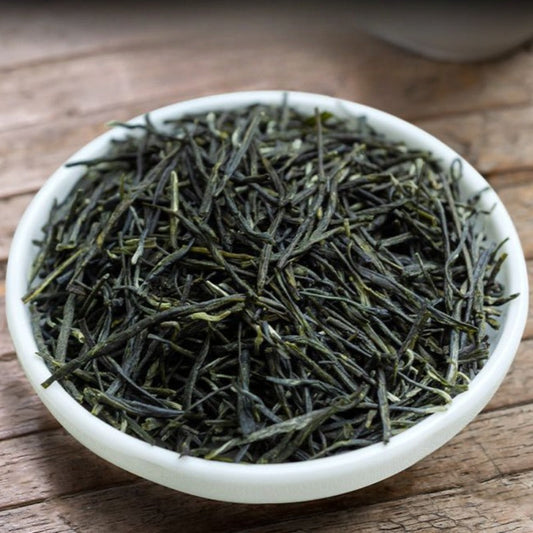Maojian Tea: The Elegant Poem of Spring on Your Tongue
——A Tasting Guide & Flavor Profile
1. Introduction: The Graceful "Fairy" of Green Teas
Maojian (毛尖), one of China's top ten famous teas, is a type of green tea renowned for its slender, smooth, and needle-like appearance and its fresh, sweet, and mellow taste. Its name comes from the fine, downy tips (毫, háo) that cover the young leaves. The most famous varieties include Xinyang Maojian (信阳毛尖, from Henan) and Duyun Maojian (都匀毛尖, from Guizhou), with Xinyang Maojian often hailed as the "King of Green Teas."
Key Characteristics:
l Appearance: Slender, uniform buds with silvery-white fuzz, vibrant emerald-green hue.
l Aroma: Delicate and floral, with notes of chestnut, orchid, and fresh grass.
l Taste: Crisp and sweet, with a lingering honey-like aftertaste and a refreshing finish.
2. Tasting Guide: Five Steps to Appreciate Maojian
-
Observe the Leaves
l High-quality Maojian has tight, straight, and evenly sized buds covered in fine white hairs. Avoid dull or yellowish leaves.
-
Inhale the Fragrance
l Warm your cup, add the leaves, and gently shake to release the dry aroma—expect floral, nutty, or fresh grassy notes. After brewing, the scent should be lively, not grassy or burnt.
-
Admire the Liquor
l The brewed tea should be clear and bright, ranging from pale green to light yellow (Xinyang: yellow-green; Duyun: jade-green). Cloudiness suggests poor processing.
-
Savor the Flavor
l First infusion (85°C, 10 sec): Sweet and delicate, like young peas and spring flowers.
l Second & third infusions (90°C, 15 sec): Fuller body, pronounced sweetness, and a cooling throat sensation.
l Beyond four infusions: Extend steeping time—subtle sweetness remains.
-
Examine the Leaves
l Post-brewing, the leaves should be soft, intact, and bright green, with no red stems or dark spots.
3. Brewing Secrets: The Art of Temperature & Time
l Water Temp: 80–85°C (too hot = bitterness).
l Tea-to-Water Ratio: 1:50 (e.g., 3g tea for 150ml water).
l Best Vessels: Glass cup (to watch leaves dance) or porcelain gaiwan (to concentrate aroma).
l Pouring Technique: Gently along the cup’s side to protect tender leaves.
4. Flavor Pairings: A Symphony on the Palate
l Pure Enjoyment: Best sipped alone to appreciate its natural freshness.
l With Snacks: Light sweets (dragon beard candy, mung bean cake) or lightly salted nuts.
l Creative Mixes: Cold-brewed Maojian with honey and lemon for summer.
5. Storage Tips: Preserving the Essence of Spring
Maojian is delicate—protect its freshness by:
1. Airtight & dark (use tin cans or foil-lined bags).
2. Refrigerate (0–5°C), but let it reach room temperature before opening to avoid condensation.
3. Consume within 12 months after opening.
Final Note: Maojian is spring captured in a cup—a harmony of mountain breeze and artisan skill. Each sip whispers the poetry of tender leaves and dew-kissed dawn.

![Early Spring Xinyang Premium [Mao Jian] Fried Green Tea 260/520g - YIQIN TEA HOUSE | yiqinteahouse.com | green tea, mao jian, tea](http://yiqinteahouse.com/cdn/shop/files/327d143e8fdaa61d450cd0ab418b303f.jpg?v=1735775728&width=533)

